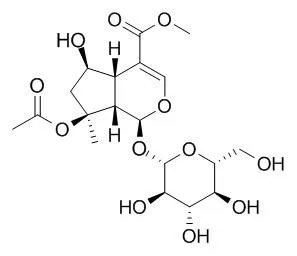| In vivo: |
| Basic Clin Pharmacol Toxicol. 2011 Jan;108(1):21-7. | | Effect of 8-O-acetyl shanzhiside methylester increases angiogenesis and improves functional recovery after stroke.[Pubmed: 20735376] | We investigated whether 8-O-Acetylshanzhiside methyl ester (ND01) regulates angiogenesis and thereby improves functional outcome after stroke.
METHODS AND RESULTS:
Adult male rats were subjected to 1 hr of middle cerebral artery occlusion (MCAO) and reperfusion, and treated with or without different doses (5 and 10 mg/kg) of ND01, starting 24 hr after ischaemia and reperfusion (I/R) and by intravenous injection daily for 14 days. Neurological functional tests were performed and cerebral Evans blue extravasation was measured. Angiogenesis and angiogenic factor expression were measured by immunohistochemistry and Western blot, respectively.
CONCLUSIONS:
The results indicated that ND01 significantly promoted angiogenesis in the ischaemic brain and improved functional outcome after stroke. ND01 also significantly increased vascularization compared with vehicle treatment. ND01 increased the expression of VEGF, Ang1, phosphorylation of Tie2 and Akt VEGF. The Ang1/Tie2 axis and Akt pathways appear to mediate ND01-induced angiogenesis. | | J Ethnopharmacol . 2016 Jul 1;187:232-8. | | A new anti-fibrinolytic hemostatic compound 8-O-acetyl shanzhiside methylester extracted from Lamiophlomis rotata[Pubmed: 27085939] | | Abstract
Background: Fibrinolysis prevents blood clots from growing and becoming problematic. Antifibrinolytics are used as inhibitors of fibrinolysis. Aprotinin was doubted after identification of major side effects, especially on kidney. Lysine analogues has their own defects and whether they are adequate substitutes for aprotinin is still under doubt. Lamiophlomis rotata (Benth.) Kudo. was previous found to have hemostatic activity. But the active compound in L. rotata and its hemostatic mechanism were unknown.
Objectives: To find the major hemostatic compound in L. rotata and identify its haemostasis mechanism.
Methods: Traumatic hemorrhage model and coagulant activity assays were monitored in mice and platelets in drug treatment group and control group. Hyperfibrinolysis model was established by intravenous administration of urokinase in mice. Capillary blood clotting time (CBCT), activated partial thromboplastin time (APTT), prothrombin time (PT), thrombin time (TT), fibrinogen and euglobulin clot lysis time (ECLT) were measured.
Results: The anti-fibrinolytic activity come from 8-O-Acetyl shanzhiside methylester (ASM) one of the highest iridoid glycosides contents in TIG extracted from L. rotata. ASM significantly (P<0.05) shorten CBCT and reduced blood loss volume in vivo, but did not influence mice APTT, PT or TT. In particular, it significantly prolonged ECLT in hyperfibrinolysis mice. It indicated that ASM could inhibit fibrinolysis. ASM was also effective in CBCT, traumatic bleeding volume and ECLT in hyperfibrinolysis mice model.
Conclusions: ASM was the major hemostatic compound in L. rotata. The haemostasis mechanism of ASM was achieved by anti-fibrinolytic activity. ASM was a new fibrinolysis inhibitor as iridoid glycoside compound.
Keywords: Antifibrinolytics; Bleeding volume; Hemostatics; Hyperfibrinolysis; Iridoid glycosides. |
|






 Cell. 2018 Jan 11;172(1-2):249-261.e12. doi: 10.1016/j.cell.2017.12.019.IF=36.216(2019)
Cell. 2018 Jan 11;172(1-2):249-261.e12. doi: 10.1016/j.cell.2017.12.019.IF=36.216(2019) Cell Metab. 2020 Mar 3;31(3):534-548.e5. doi: 10.1016/j.cmet.2020.01.002.IF=22.415(2019)
Cell Metab. 2020 Mar 3;31(3):534-548.e5. doi: 10.1016/j.cmet.2020.01.002.IF=22.415(2019) Mol Cell. 2017 Nov 16;68(4):673-685.e6. doi: 10.1016/j.molcel.2017.10.022.IF=14.548(2019)
Mol Cell. 2017 Nov 16;68(4):673-685.e6. doi: 10.1016/j.molcel.2017.10.022.IF=14.548(2019)